This article was medically reviewed by Sheilagh Maguiness, MD and by wikiHow staff writer, Jennifer Mueller, JD. Dr. Sheilagh Maguiness is a board certified Pediatric Dermatologist. Dr. Maguiness has a strong commitment to patient and family education surrounding pediatric skin conditions. Her clinical and research interests include atopic dermatitis/eczema, acne and the diagnosis and management of vascular anomalies including hemangiomas, capillary malformations (port-wine stains), and complex vascular birthmarks. Dr. Maguiness received her MD from the University of Western Ontario, completed a dermatology residency at the University of Alberta, and trained in fellowship in pediatric dermatology at the University of California - San Francisco.
There are 13 references cited in this article, which can be found at the bottom of the page.
wikiHow marks an article as reader-approved once it receives enough positive feedback. In this case, 100% of readers who voted found the article helpful, earning it our reader-approved status.
This article has been viewed 2,716,799 times.
An armpit rash can be so itchy and irritating, you probably want to get rid of it as soon as possible. How you need to treat your rash for speedy healing really depends on what caused it—so it's important to take a moment to figure that out. Once you've got the probable cause nailed down, pick the treatment that works best for that type of rash. Typically, all it takes is a little self-care at home and your rash will be history in no time.
Things You Should Know
- Determine the cause of your rash first so you can apply the correct treatment.
- Regardless of the cause, wash the rash with mild soap and warm water, then pat it dry.
- Keep the area cool and dry while your skin is healing.
- Wear loose-fitting clothing made of natural fibers to allow the skin to breathe for quicker healing.
Steps
Causes
-
1Heat
Being in a hot environment can cause a rash to break out under your arms as well as other areas of your body where the skin touches. This is especially likely if you're sweating a lot and wearing clothes that are tight or made of synthetic material that keep moisture close to your skin.[1]- A heat rash usually doesn't itch—it's more likely that it feels prickly and uncomfortable.
-
2Chafing
If you're moving around a lot in such a way that your skin is rubbing together, your underarms can become chafed. Like with a heat rash, it's going to get even worse if you're wearing a shirt with tight sleeves that are made of a synthetic material that doesn't allow your skin to breathe.[2]- Chafing happens as a result of the friction of your skin rubbing together. It's also more likely if your skin isn't properly moisturized.
Advertisement -
3Allergy
A rash can develop if your underarms are exposed to some sort of chemical or ingredient that you're allergic to. This type of rash is usually red and can get very itchy. If you've recently started using a different deodorant or antiperspirant, or if you've changed your laundry detergent or fabric softener, that might be the source of your problem.[3]- You can develop an allergy at any point in your life, even if you've never had a problem with a particular product. That's something to keep in mind if you haven't switched brands recently.
- If you've recently started taking a new medication or supplement, the rash might be a side effect. Talk to your doctor about it—they can adjust your dosage or suggest an alternative.
- If you really want to find out for sure what you might be allergic to, talk to your doctor about doing allergy tests. These tests won't do anything for your rash, but at least you'll know for sure what you're allergic to so you can avoid it in the future.
-
4Eczema
Eczema is so itchy that some people call it "the itch that rashes." If you're not allergic to anything but you still have an itchy red rash in your armpits, you might have eczema. Typically, a doctor would make that diagnosis, but there are still at-home treatments you can do to manage the symptoms of this condition.[4]- If you've had eczema before on another part of your body, or if someone in your family has had problems with eczema, it's more likely that this is the culprit.
-
5Yeast infection
You probably associate yeast infections with another part of your body, but armpits are prone to them as well. Here, you're looking for a bright red rash that's usually intensely itchy. You might also feel a burning sensation. A doctor can give you an official diagnosis, but you can typically treat a mild infection at home on your own.[5]- Candida, the bacteria that causes this infection, really loves warm, moist environments, so if you're out in the heat working up a sweat, you might have a yeast infection. The itch and burning sensation set this apart from a heat rash.
- This is more likely if you're wearing tight clothing made of synthetic fabrics that leave the sweat trapped in your armpits—that's creating the warm, moist environment candida craves.
-
6Hair removal processes
If you shave your pits frequently, you might end up with folliculitis, which is an infection of your hair follicles. This can cause a rash that might look similar to razor burn, or it could look a little like acne. Your skin might be tender as well, although it usually doesn't itch.[6]- If you wax or use a depilatory cream, you might also get a rash this way, although it's less likely. These processes are more likely to cause inflammation or an allergic reaction.
-
7Stress
Being under a lot of stress can cause you to break out in a rash anywhere on your body. Armpits are a prime target, though, because they're typically warm and moist. A stress rash may be bright red spots or just an overall flush to the skin, as though you had a sunburn. It doesn't always itch.[7]
Treatments
-
1Stop using any product you think might be causing an allergic reaction. While an allergic rash can be uncomfortable and itchy, it's usually pretty easy to treat. As soon as you figure out what caused it and stop exposing your skin to that irritant, the rash will pretty much disappear on its own.[8]
- Of course, figuring out what you're allergic to is sometimes easier said than done. If you haven't recently started using a new product, this might involve a lot of trial and error.
- If your allergic reaction is a side effect of a new medication, don't stop taking it without talking to your doctor first.
-
2Wash the affected area with soap and water. Use a mild soap and warm water, and pat the area to clean it—don't rub! When you're done, rinse off all the soap and pat the area dry.[9]
- If your rash was caused by contact with an irritant, make sure you've removed all traces of the irritant from your skin. That'll help the rash clear up more quickly.
-
3Apply a cool compress to your armpit to reduce swelling and inflammation. Use ice in a plastic bag or a bag of frozen vegetables wrapped in a T-shirt or a towel. If you've got a rash on both armpits, feel free to make two. Leave the compress on the rash for 15-20 minutes, then remove it.[10]
- This treatment is most effective if you have a heat rash, as it rapidly cools your skin. But it also provides relief if the rash feels hot or inflamed.
- If the cool compress provides you with relief, continue to do it as often as once every 4 hours or so.
-
4Move out of the heat and sun to calm a heat rash. If you start developing a heat rash, it's important to cool yourself down as quickly as possible. If you can, get somewhere inside with air conditioning, take off your shirt, and hold your arms up to let your armpits air out a little bit.[11]
- It might also help to stand in front of a fan—cool air blowing directly on your skin will help you cool down more quickly.
-
5Smooth on an anti-itch cream or ointment. If your rash itches, you don't want to scratch it, so anti-itch cream can be really helpful. Wash the area and pat it dry before you apply the cream or ointment, following the instructions on the package.[12]
- If your rash was caused by chafing, aloe vera gel or petroleum jelly can also help protect the area while it heals.[13]
-
6Coat the rash in talcum or baby powder. It's important to keep your skin dry so the rash will heal as quickly as possible—but that can be tough when the rash is in your armpit. A drying powder will help keep the skin as dry as possible. Just scoop a bit of the powder up with the tip of your finger and pat it gently onto your skin.[14]
- This also works as a preventive measure! A little powder in your pits, even if you don't have a rash, can reduce friction and moisture and keep you from getting one.[15]
- Powder can leave streaks on your clothing and might not come out of some fabrics. If you're not sure, test it on an inconspicuous area before you wear the shirt.
-
7Take a lukewarm bath with colloidal oatmeal to soothe itching. Grind about 27 ounces (770 g) of unflavored rolled oats into a fine powder using a food processor. Fill a bath with warm water, adding 9 to 13.5 ounces (260 to 380 g) of powdered oats. Soak in the bath for 10 to 15 minutes, being sure to submerge your armpits. Then, get out and pat yourself dry with a towel.[16]
- "Colloidal" oatmeal just refers to finely milled oats that are suspended in a liquid, such as water—it's not a brand or specific type to look for.
-
8Take a vitamin C supplement to combat an infection. The best way to get vitamin C is through the foods you eat, including any kind of citrus fruit, tomatoes, or cruciferous vegetables such as broccoli and cauliflower. But a supplement helps boost your vitamin C levels so you have enough of the substance to help calm the rash and clear away any infection.[17]
- Don't take more than 2000 mg of vitamin C in one day—that much vitamin C could harm your body (at a minimum, you'll likely have some bad diarrhea).
-
9Stop shaving for a couple of days if your hair follicles are infected. Regardless of the cause of your rash, shaving your inflamed skin isn't going to help the situation. But if your rash was caused specifically by shaving, your skin will only start to heal if you stop for a few days.[18]
- Continue to treat the rash with an anti-itch gel or cream so you're not tempted to scratch it. Wash with mild soap and warm water at least twice a day to keep the area clean.
-
10Use an anti-fungal cream for a candida infection. Wash your armpits first and pat them dry, then rub the cream directly into your skin. Keep your arms up or out until the cream is completely absorbed to keep from rubbing it off.[19]
- Different brands may recommend slightly different methods of application. Read and follow the instructions on the package of the cream for the best results.
-
11Apply an unscented moisturizer to treat eczema. Use a gentle cream moisturizer and keep your arms up until it dries. Light lotions aren't going to work as well—they're just not strong enough to penetrate your skin and provide long-term moisture.[20]
- Oil or petroleum-based moisturizers are also effective, but you might not like how they feel on your skin. Oil that isn't completely absorbed can also potentially stain your clothing.
- Continue to use the same moisturizer if it works well for your skin. Keeping your skin well moisturized will prevent the rash from coming back, especially if it was originally caused by dry skin or chafing.
Prevention
-
1Wear loose-fitting clothing made of natural materials. Synthetic fabric doesn't allow for proper airflow and traps sweat, body heat, and moisture in your armpits. Likewise, clothing that's too tight can rub against your skin and irritate it (as well as further restrict airflow).[21]
-
2Switch to a mild laundry detergent and lose the fabric softener. When you do your laundry, the detergent doesn't always rinse completely out of your clothes, and those particles can irritate your skin. Mild, unscented detergents that are free of dyes are usually the best for sensitive skin. Since fabric softener always leaves traces on your clothes, you're probably better off without it if you're prone to rashes.[22]
- Try dryer balls if you're looking for a way to control static and keep your clothes from being too stiff out of the dryer (an old tennis ball works just fine for this).
-
3Avoid intense physical activity outside when it's hot and humid. Exercise is important, but if you're prone to heat rashes, be careful of when, where, and how hard you work out. Take frequent breaks and watch for friction in the armpit area.[23]
- For example, if you run outside, you might run early in the morning or later in the evening when it's not as hot.
-
4Wash your armpits daily using a mild soap. Don't use bar soap, which can dry out your skin and make your rash worse. A gentle liquid body wash is best—you could even try a body wash formulated for babies.[24]
- With any kind of rash, good hygiene is super important. Make sure you're keeping your armpits clean and dry, especially after exercise or when you come in from outside.
-
5Change your brand of deodorant or antiperspirant. If you think your rash was an allergic reaction, using a different deodorant or antiperspirant might help. Take your old one along with you when you shop so you can compare ingredients.[25]
- This can be tough if you don't know exactly what ingredient triggered the reaction. You might want to get several smaller, travel-size deodorants so you can try several and see which one works best for you.
-
6Drink plenty of water to stay well-hydrated. Cool water is always the best choice to stay hydrated. If you're overheated, it can also help lower your internal body temperature, which is great to help your system calm down so the rash will subside.[26]
- Avoid energy drinks, coffee, and other hot drinks that will raise your internal temperature.
- Energy drinks, soft drinks, and coffee are also diuretics that could lead to dehydration.
-
7Meditate to ease stress and calm your nerves. Start a meditation practice to rewire your brain to look at life differently and more calmly. Negative events won't affect you as terribly when you have a good mood and relaxed mindset.[27]
- Other relaxation techniques work too—basically, anything that helps you control the stress in your life is going to decrease your chances of getting another rash in the future.
- For example, you might decide to take up yoga or start doing tai chi, both of which are excellent for controlling and managing stress.
Warnings
- Don't scratch the rash—you'll damage your skin and could cause it to become infected or spread to other parts of your body.[29]⧼thumbs_response⧽
- Seek emergency medical treatment if your rash bleeds or oozes, is painful, or if you also have a fever and nausea.⧼thumbs_response⧽
- Never use a triple-antibiotic ointment, such as Neosporin, on a rash. It doesn't kill the bacteria that cause skin infections and can lead to an additional allergic reaction.[30]⧼thumbs_response⧽
References
- ↑ https://www.healthdirect.gov.au/heat-rash
- ↑ https://my.clevelandclinic.org/health/diseases/23517-chafing
- ↑ https://medlineplus.gov/ency/article/000869.htm
- ↑ https://kidshealth.org/en/parents/eczema-atopic-dermatitis.html
- ↑ https://my.clevelandclinic.org/health/diseases/22908-armpit-yeast-infection
- ↑ https://my.clevelandclinic.org/health/diseases/17692-folliculitis
- ↑ https://kidshealth.org/en/parents/eczema-atopic-dermatitis.html
- ↑ https://medlineplus.gov/ency/article/000869.htm
- ↑ https://medlineplus.gov/ency/article/000869.htm
- ↑ https://www.nhs.uk/conditions/heat-rash-prickly-heat/
- ↑ https://www.healthdirect.gov.au/heat-rash
- ↑ https://medlineplus.gov/ency/article/000869.htm
- ↑ https://my.clevelandclinic.org/health/diseases/23517-chafing
- ↑ https://my.clevelandclinic.org/health/diseases/22908-armpit-yeast-infection
- ↑ https://my.clevelandclinic.org/health/diseases/21693-intertrigo
- ↑ https://www.michigan.gov/-/media/Project/Websites/flintwater/documents/2016/Dos_and_Donts_of_Rashes_Dr_Barkey.pdf?rev=c0c862215cc04642ad1fcfdcf377c6f8
- ↑ https://www.hsph.harvard.edu/nutritionsource/vitamin-c/
- ↑ https://my.clevelandclinic.org/health/diseases/17692-folliculitis
- ↑ https://my.clevelandclinic.org/health/diseases/22908-armpit-yeast-infection
- ↑ https://www.michigan.gov/-/media/Project/Websites/flintwater/documents/2016/Dos_and_Donts_of_Rashes_Dr_Barkey.pdf?rev=c0c862215cc04642ad1fcfdcf377c6f8
- ↑ https://kidshealth.org/en/parents/eczema-atopic-dermatitis.html
- ↑ https://medlineplus.gov/ency/article/000869.htm
- ↑ https://www.seattlechildrens.org/conditions/a-z/heat-rash/
- ↑ https://www.michigan.gov/-/media/Project/Websites/flintwater/documents/2016/Dos_and_Donts_of_Rashes_Dr_Barkey.pdf?rev=c0c862215cc04642ad1fcfdcf377c6f8
- ↑ https://medlineplus.gov/ency/article/000869.htm
- ↑ https://kidshealth.org/en/parents/eczema-atopic-dermatitis.html
- ↑ https://www.cdc.gov/mentalhealth/stress-coping/cope-with-stress/index.html
- ↑ https://www.aad.org/public/diseases/itchy-skin/poison-ivy-oak-and-sumac#treatment
- ↑ https://www.michigan.gov/-/media/Project/Websites/flintwater/documents/2016/Dos_and_Donts_of_Rashes_Dr_Barkey.pdf?rev=c0c862215cc04642ad1fcfdcf377c6f8
- ↑ https://www.michigan.gov/-/media/Project/Websites/flintwater/documents/2016/Dos_and_Donts_of_Rashes_Dr_Barkey.pdf?rev=c0c862215cc04642ad1fcfdcf377c6f8
About This Article
To heal an armpit rash, start by washing the affected area with soap and water daily to prevent the infection from getting worse. Next, place an ice pack or a damp towel on the rash for 10-15 minutes to reduce the swelling. You can also apply a medicated anti-itch cream to alleviate the irritation. If you’d prefer to use a home remedy, try patting some talcum powder on the rash every day to absorb any sweat or taking a warm bath with colloidal oatmeal to soothe the skin. For more tips from our Medical reviewer, like how to prevent future rashes, keep reading!
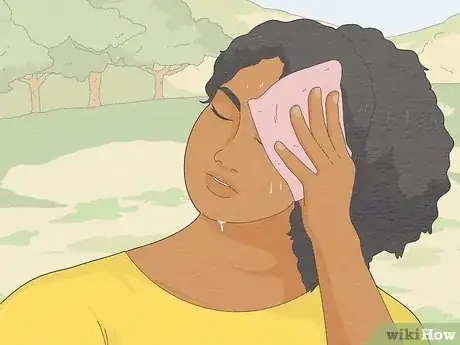



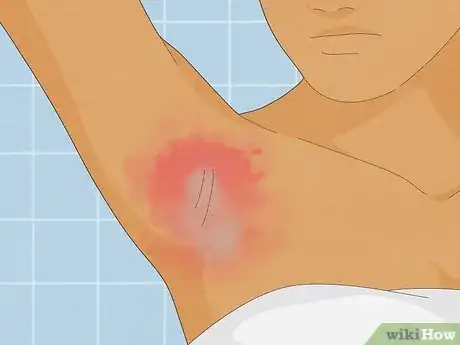
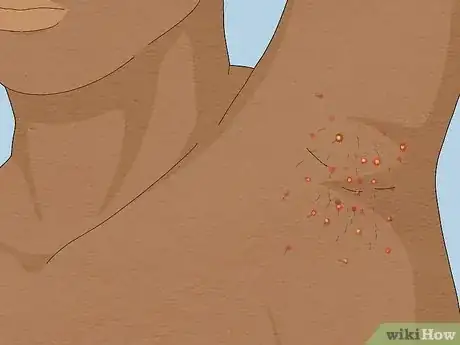

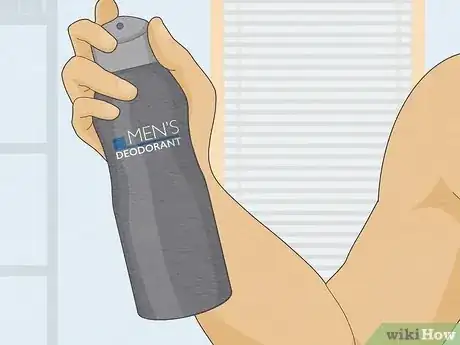

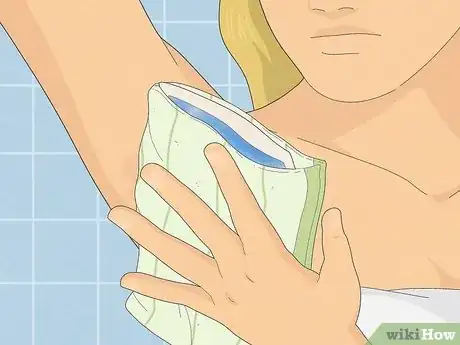


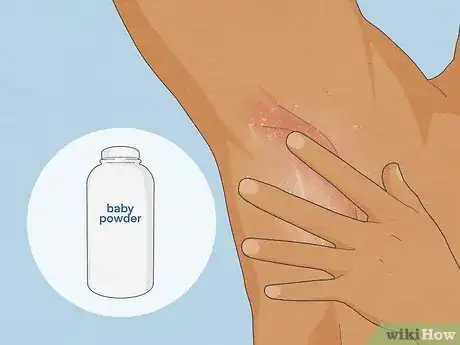

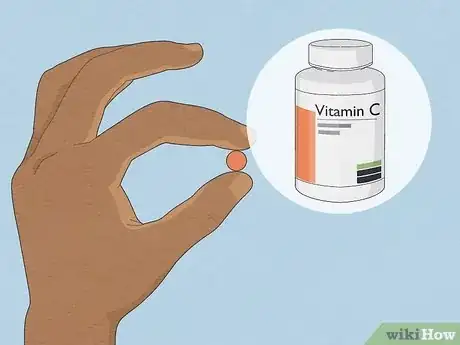
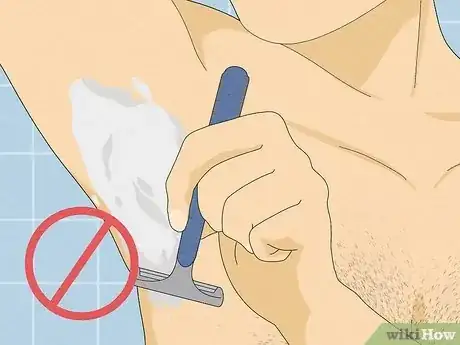
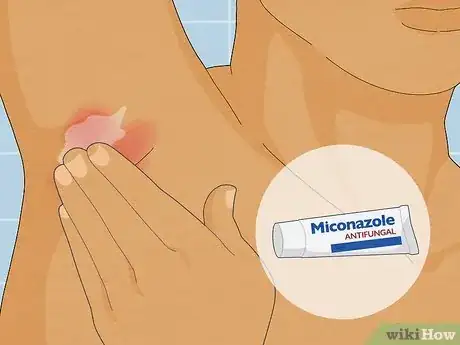
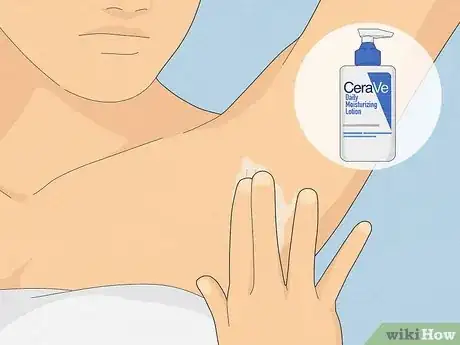
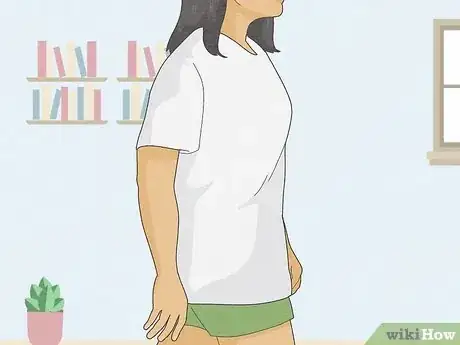
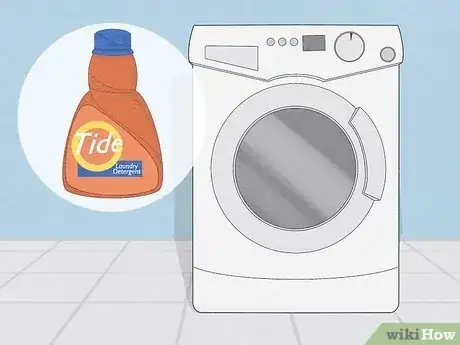

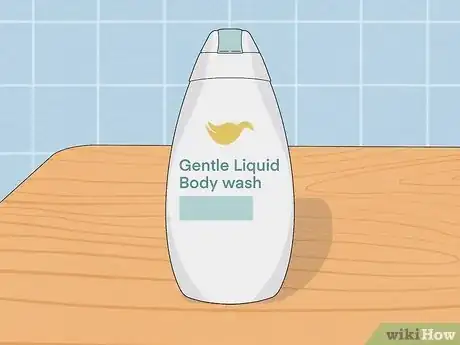
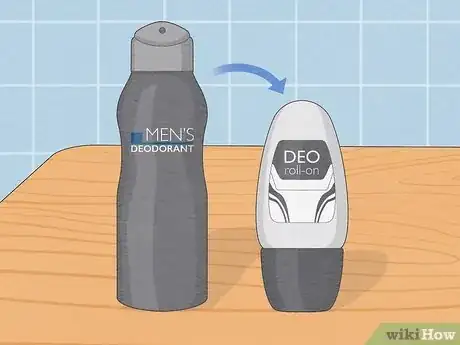
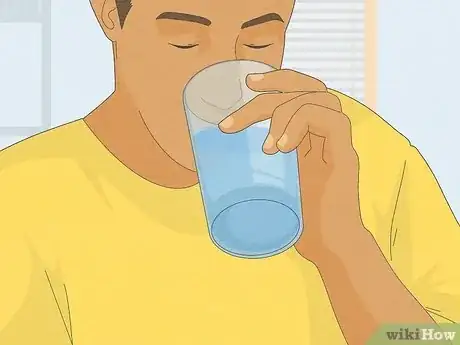
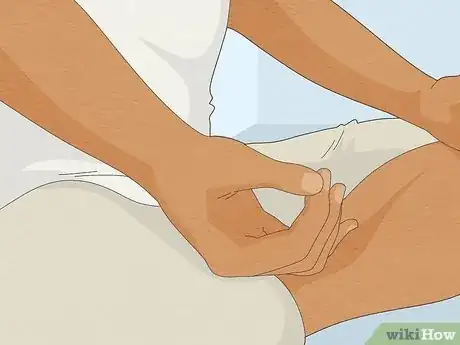


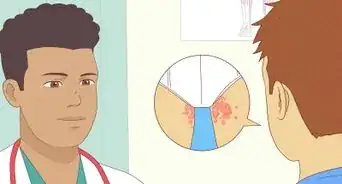






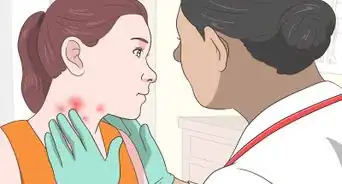

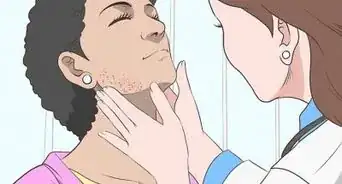



















































Medical Disclaimer
The content of this article is not intended to be a substitute for professional medical advice, examination, diagnosis, or treatment. You should always contact your doctor or other qualified healthcare professional before starting, changing, or stopping any kind of health treatment.
Read More...